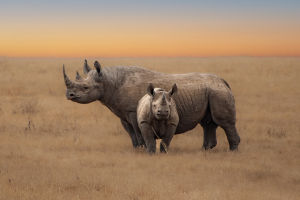Lions, often called the kings of the jungle, are majestic creatures that face significant threats to their survival. Human activity, including poaching and habitat loss, has drastically reduced their numbers.
In this article, we share some of the most fascinating lion facts and why they need our help.
1. A Lion's Roar Can Be Heard Eight Kilometres Away
The roar of a lion is not only loud but powerful. Reaching up to 114 decibels—louder than a chainsaw—lions use their roar to communicate with other members of their pride, mark territory, and warn rivals.
Their specialized vocal cords, square and flat rather than triangular, allow them to produce these deep, resonating sounds, which can be heard from distances of up to 8 km.
2. Not All Lions Live in Africa
While Africa is often associated with lions, there’s a small population of Asiatic lions in India’s Gir Forest. These lions are smaller than their African relatives and live in dense forests rather than open savannahs. Today, only around 350 Asiatic lions remain, making them critically endangered and in need of urgent conservation efforts.
3. Hundreds of Lions Are Poached Every Year
Poaching is a major threat to lion populations. Despite conservation efforts, an estimated 600 lions are killed annually by poachers. This has devastating effects not only on lions but on the ecosystems they maintain.
4. Ugandan Lions Are Excellent Tree Climbers
Lions in Uganda’s Queen Elizabeth National Park have been observed climbing trees, a rare behavior for such large cats. This behavior helps them avoid the heat and gain a better vantage point.
5. Lions Once Lived in Europe
Lions were once found in southern Europe, with fossil evidence showing that they roamed the region as far back as the Ice Age. These ancient lions were larger and more robust than modern lions and were adapted to colder climates.
6. Lion Cubs Are Born Spotted
When lion cubs are born, they have spots and rosettes, a camouflage feature that helps them blend into their surroundings and avoid predators.
7. Not All Lions Have Manes
The iconic lion’s mane, especially on males, is not universal. Some lions, particularly those in Tsavo, Kenya, are maneless. This adaptation may help them navigate the dense, thorny vegetation of their habitat.
8. Lions Are the Only Cats to Live in Groups
Unlike other big cats, lions are social animals that live in prides, which can consist of related females, their cubs, and a few males. Living in groups helps lions hunt more efficiently and protect their young.
9. Lions Are Victims of Wildlife Crime
Lions are often victims of the illegal wildlife trade. Their body parts—teeth, claws, bones, and skin—are highly valued in black markets for use in traditional medicine and trophies.
10. Lions Only Eat Twice a Week
Despite their large size, lions don’t eat daily. They hunt large herbivores like zebras and wildebeest, sometimes consuming up to 50 kg (110 pounds) of meat in one sitting.
Lions are incredible creatures, but their survival is at risk. Conservation efforts are critical to ensure that these majestic animals continue to thrive in the wild. To learn more or help protect lions, consider supporting organizations working to save them.
Top 10 Facts About Lions | Animal Fun Facts | WWF
Video by WWF UK


